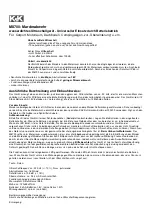
OVERSCAN-BOUNCE.
www.gmetechnology.com
7
The Overscan-Bounce pattern consists of 4 horizontal lines on the top and bottom edge of the
screen and 4 vertical lines at the left and right edge of the screen. These lines mark 2.5%, 5%,
7.5%, and 10% of the width and height of the screen. The background of the screen alternates
between black and white.
This pattern is useful for checking the amount of overscan of a display monitor. The 4 lines at
each of the four edges are helpful in determining whether there is equal amount of overscan
at the sides or at the top and bottom of the screen. Adjust the display device’s geometry
controls to obtain the desire amount of overscan or underscan.
The Overscan-Bounce pattern is also useful for checking pincushion (bow) distortion and
display geometry such as picture centering, size, and trapezoid (keystone) correction and
linearity. For trapezoid correction, adjust the TV’s display control so that the pattern’s edges
are parallel to the edges of the display screen. For pincushion correction, the horizontal and
vertical lines should be adjusted to be straight.
It is also used to check the stability of the high-voltage and deflection power supply circuits.
The Overscan Bounce pattern changes repeatedly from a low to high APL (average picture
level). As the picture APL changes, the picture size may momentarily expand and contract.
The amount of change can be measured by the shift of the lines on the screen edges.
Summary of Contents for HG139
Page 1: ...GME User s Manual Rev 1 1...
Page 17: ...www gmetechnology com 13 Notes...




































